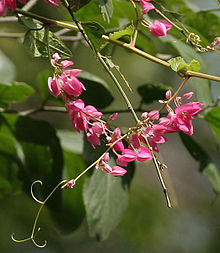Antigonon leptopus
| Antigonon leptopus | |
|---|---|

| |
| Scientific classification | |
| Kingdom: | Plantae |
| Clade: | Tracheophytes |
| Clade: | Angiosperms |
| Clade: | Eudicots |
| Order: | Caryophyllales |
| Family: | Polygonaceae |
| Genus: | Antigonon |
| Species: | A. leptopus
|
| Binomial name | |
| Antigonon leptopus | |
| Synonyms[2] | |
| |
Antigonon leptopus, commonly known as Mexican creeper, coral vine, Coralita, bee bush (in many Caribbean islands) or San Miguelito vine, is a species of flowering plant in the buckwheat family, Polygonaceae. It is a perennial that is native to Mexico. It is a vine with pink or white flowers (Antigonon leptopus 'alba' ).
Invasive species
This plant is listed as a category II invasive exotic by the Florida's pest plant council.
Description

Antigonon leptopus is a fast-growing climbing vine that holds on via tendrils, and is able to reach 25 ft or more in length. It has cordate (heart shaped), sometimes triangular leaves 2½ to 7½ cm long. The flowers are borne in panicles, clusted along the rachis. Producing pink or white flowers from spring to autumn, it forms underground tubers and large rootstocks. It is a prolific seed producer. The seeds float on water. The fruit and seeds are eaten and spread by a wide range of animals such as pigs, raccoons and birds. The tubers will resprout if the plant is cut back or damaged by frost.

Uses
Antigonon leptopus was prepared for consumption by the aboriginal inhabitants of Baja California in a way somewhat reminiscent of preparing popcorn. The seeds were toasted by placing them in a flat basket made of flexible twigs torn into strips and woven to make a solid surface. On top of the seeds were placed live coals, and with both hands the basket was shaken so that the coals came up against the seeds, toasting them, but not burning the basket. When the toasting was finished, the burned-out coals were removed. Using this method, a major portion of the seeds burst open, exposing a white meal. Afterwards the seeds were separated from the husks from which they had emerged by dextrously tossing them into the air with the basket, in the same way that wheat is winnowed in Spain. The seeds were then ground and the resulting meal was eaten. Alternatively the seeds could be boiled and made into fried cakes.[3]
References
- ^ "Antigonon leptopus". Germplasm Resources Information Network. Agricultural Research Service, United States Department of Agriculture. Retrieved 2010-10-21.
- ^ "The Plant List: A Working List of All Plant Species". Retrieved May 16, 2014.
- ^ Aschmann, Homer (1952). "A Primitive Food Preparation Technique in Baja California". Southwestern Journal of Anthropology. 8 (1): 36–39. doi:10.2307/3628552 (inactive 2018-08-23). JSTOR 3628552.
{{cite journal}}: CS1 maint: DOI inactive as of August 2018 (link)
External links
![]() Media related to Antigonon leptopus at Wikimedia Commons
Media related to Antigonon leptopus at Wikimedia Commons
- Dressler, S.; Schmidt, M. & Zizka, G. (2014). "Antigonon leptopus". African plants – a Photo Guide. Frankfurt/Main: Forschungsinstitut Senckenberg.
